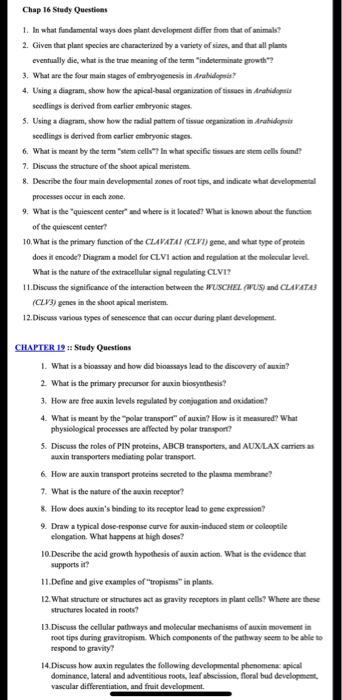
Chap 16 Study Questions 1. In what fundamental ways does plant development differ from that of animals? 2. Given that plant species are characterized by a variety of sines, and that all plants eventually die, what is the true meaning of the term "indeterminate growth? 3. What are the four main stages of embryogenesis in Arabidopsis 4. Using a diagram, show how the apical-basal organization of tissues in Arabidopsis seedlings is derived from earlier embryonic stages 5. Using a diagram, show how the radial pattom of tissue organization in Arabidopsis seedlings is derived from earlier embryonic stages 6. What is meant by the term stem cells? In what specific tissues are stem cells found 7. Discuss the structure of the shoot apical meristem 8. Describe the four main developmental zones of root tips and indicate what developmental processes occur in each one. 9. What is the "quiescent center and where is it located? What is known about the functie of the quiescent center? 10. What is the primary function of the CLAVATAI (CLV1) gene, and what type of protein does it encode? Diagram a model for CL.VI action and regulation at the molecular level What is the nature of the extracellular signal regulating CLVI? 11. Discuss the significance of the interaction between the WUSCHEL (US) and CLAVATAS (CLV3) genes in the shoot apical meristem. 12. Disces various types of senescence that can occur during plant development CHAPTER 19: Study Questions 1. What is a bioassay and how did bioassays lead to the discovery of aukin? 2. What is the primary precunser for auxin biosynthesis? 3. How are free auxin levels regulated by conjugation and oxidation? 4. What is meant by the polar transport of auxin? How is it measured? What physiological processes are affected by polar transport? 5. Discuss the roles of PIN proteins, ABC transporters, and AUX LAX carries ** auxin transporters mediating polar transport 6 How are suxin transport protein secreted to the plasma membrane! 7. What is the nature of the auxin receptor? & How does auxin's binding to its receptor lead to gene expression? 9. Draw a typical dose-response curve for auxin-induced stem or coleoptile clongation. What happens at high doses? 10. Describe the acid growth hypothesis of aurin action. What is the evidence that supports it? 11. Define and give examples of "tropisms" in plants. 12. What structure of structures act as gravity receptors in plant cells? Where are structures located in roots? 13.Discuss the cellular pathways and molecular mechanisms of aukin movement in root tips during gravitropism. Which components of the pathway seem to be able to respond to gravity? 14 Discuss how auxin regulates the following developmental phenomena apical dominance, lateral and adventitious roots, leaf abscission, floral bud development vascular differentiation, and fruit development.
CHAPTER 20 : Study Questions 1. What are the common chemical features of gibberellins, and to which general class of compounds are they related? Are all gibberellins biologically active? 2. Briefly describe seven different physiological responses to GA, 3. What are some commercial applications of GA in agriculture? 4. Which pathway produces the early intermediates for GA biosynthesis? What three cellular compartments are involved in gibberellin biosynthesis, and what are the major biochemical steps in each compartment? 5. How can plant height be altered through genetic engineering? 6. What are the three main classes of gibberellin response mutants, and how do they differ from mutants blocked in GA biosynthesis? 7. What effect does GA-binding have on the GIDI receptor? 8. What is the role of DELLA proteins in the GA response? How does GA-binding to its receptor affect DELLA proteins? Describe the series of steps following GA-binding that leads to the GA response. 9. How do cereal aleurone layers respond to GA, and what role does this response play in germination? 10. What is the role of the GAMYB protein in the response of barley aleurone layers to GA? CHAPTER 21 : Study Questions 1. Name one plant diseases that are associated with cytokinin overproduction. What is the source of the excess cytokinin? 2. Compare the plant and microbial pathways of cytokinin biosynthesis. What are the naturally occurring cytokinins in plants? 3. Which enzyme catalyzes the first step in cytokinin biosynthesis? What is known about the gene(s) encoding this enzyme? 4. Which enzyme is response for cytokinin degradation? 5. What is the nature of the cytokinin receptor? Compare and contrast the cytokinin receptor and signaling mechanism to bacterial two-component signaling systems. What role does phosphorylation play? 6. Which protein (or proteins) represents the response regulator" in the cytokinin signaling pathway? What is their mechanism of action? 7. Diagram the main steps in the cellular pathway for cytokinin signaling. Which steps occur in the cytoplasm and which steps occur in the nucleus? 8. Discuss the roles of cytokinins in the following developmental phenomena: shoot growth, root growth, the cell cycle, tissue culture, apical dominance, leaf senescence, and vascular development. 9. What are some potential applications of cytokinin manipulation to agriculture?
没有找到相关结果